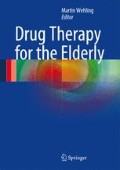Abstract
Immobility is a frequent and significant geriatric syndrome. It is associated with an-often severe loss of independence and self-management capacity. Furthermore, immobility leads to changes in physiology that are irreversible or at least difficult to revert. Long-standing or chronic immobility in this context should be distinguished from acute immobilization, with the latter showing a wide overlap with what is termed deconditioning in the geriatric field (Killewich 2006). The underlying pathophysiological mechanisms are not completely identical but show common features. The most significant of these are functional and structural changes in skeletal muscles, especially of leg extensors and trunk muscles, which are most important to maintain independent locomotion.
Access this chapter
Tax calculation will be finalised at checkout
Purchases are for personal use only
References
Anderson FA Jr, Wheeler HB, Goldberg RJ et al (1991) A population-based perspective of the hospital incidence and case fatality rates of deep vein thrombosis and pulmonary embolism. The Worcester DVT Study. Arch Intern Med 151:933–938
Baum E, Peters KM (2008) The diagnosis and treatment of primary osteoporosis according to current guidelines. Dtsch Arztebl Int 105:573–582
Bauman WA, Spungen AM, Wang J, Pierson RN Jr, Schwartz E (1999) Continuous loss of bone during chronic immobilization: a monozygotic twin study. Osteoporos Int 10:123–127
Berg HE, Eiken O, Miklavcic L, Mekjavic IB (2007) Hip, thigh and calf muscle atrophy and bone loss after 5-week bedrest inactivity. Eur J Appl Physiol 99:283–289
Comp PC, Spiro TE, Friedman RJ et al (2001) Prolonged enoxaparin therapy to prevent venous thromboembolism after primary hip or knee replacement. Enoxaparin Clinical Trial Group. J Bone Joint Surg Am 83-A:336–345
Creditor MC (1993) Hazards of hospitalization of the elderly. Ann Intern Med 118:219–223
Di Minno G, Tufano A (2004) Challenges in the prevention of venous thromboembolism in the elderly. J Thromb Haemost 2:1292–1298
Eriksson BI, Lassen MR, PENTasaccharide in HIp-FRActure Surgery Plus Investigators (2003) Duration of prophylaxis against venous thromboembolism with fondaparinux after hip fracture surgery: a multicenter, randomized, placebo-controlled, double-blind study. Arch Intern Med 163:1337–1342
Gatt ME, Paltiel O, Bursztyn M (2004) Is prolonged immobilization a risk factor for symptomatic venous thromboembolism in elderly bedridden patients? Results of a historical cohort study. Thromb Haemost 91:538–543
Geerts WH, Heit JA, Clagett GP et al (2001) Prevention of venous thromboembolism. Chest 119:132S–175S
Group Health Cooperative (2011) Osteoporosis prevention, screening, and treatment guideline copyright © 1998–2011. http://www.ghc.org/all-sites/guidelines/osteoporosis.pdf. Accessed 4 Sept 2011
Gupta V, Lipsitz LA (2007) Orthostatic hypotension in the elderly: diagnosis and treatment. Am J Med 120:841–847
Haas S, Spyropoulos AC (2008) Primary prevention of venous thromboembolism in long-term care: identifying and managing the risk. Clin Appl Thromb Hemost 14:149–158
Hussain RM, McIntosh SJ, Lawson J, Kenny RA (1996) Fludrocortisone in the treatment of hypotensive disorders in the elderly. Heart 76:507–509
Killewich LA (2006) Strategies to minimize postoperative deconditioning in elderly surgical patients. J Am Coll Surg 203:735–745
Kniffin WD Jr, Baron JA, Barrett J, Birkmeyer JD, Anderson FA Jr (1994) The epidemiology of diagnosed pulmonary embolism and deep venous thrombosis in the elderly. Arch Intern Med 154:861–866
Kolb G, Bodamer I, Galster H et al (2003) Reduction of venous thromboembolism following prolonged prophylaxis with the low molecular weight heparin Certoparin after endoprothetic joint replacement or osteosynthesis of the lower limb in elderly patients. Thromb Haemost 90:1100–1105
Kortebein P (2009) Rehabilitation for hospital-associated deconditioning. Am J Phys Med Rehabil 88:66–77
Lacut K, Le Gal G, Mottier D (2008) Primary prevention of venous thromboembolism in elderly medical patients. Clin Interv Aging 3:399–411
Luutonen S, Antila K, Erkko M, Raiha I, Rajala T, Sourander L (1995) Haemodynamic response to head-up tilt in elderly hypertensives and diabetics. Age Ageing 24:315–320
Matkovic V, Jackson RD, Mysiw WJ, Whitten R, Dekanic D (1990) Osteoporosis. In: Kottke FJ, Lehmann JF (eds) Handbook of physical medicine and rehabilitation. Saunders, Philadelphia, pp 1169–1208
Oger E, Bressollette L, Nonent M et al (2002) High prevalence of asymptomatic deep vein thrombosis on admission in a medical unit among elderly patients. Thromb Haemost 88:592–597
Paddon-Jones D, Sheffield-Moore M, Cree MG et al (2006) Atrophy and impaired muscle protein synthesis during prolonged inactivity and stress. J Clin Endocrinol Metab 91:4836–4841
Tang BM, Eslick GD, Nowson C, Smith C, Bensoussan A (2007) Use of calcium or calcium in combination with vitamin D supplementation to prevent fractures and bone loss in people aged 50 years and older: a meta-analysis. Lancet 370(9588):657–666
Author information
Authors and Affiliations
Corresponding author
Editor information
Editors and Affiliations
Rights and permissions
Copyright information
© 2013 Springer-Verlag Wien
About this chapter
Cite this chapter
Burkhardt, H. (2013). Immobility and Pharmacotherapy. In: Wehling, M. (eds) Drug Therapy for the Elderly. Springer, Vienna. https://doi.org/10.1007/978-3-7091-0912-0_23
Download citation
DOI: https://doi.org/10.1007/978-3-7091-0912-0_23
Published:
Publisher Name: Springer, Vienna
Print ISBN: 978-3-7091-0911-3
Online ISBN: 978-3-7091-0912-0
eBook Packages: MedicineMedicine (R0)

